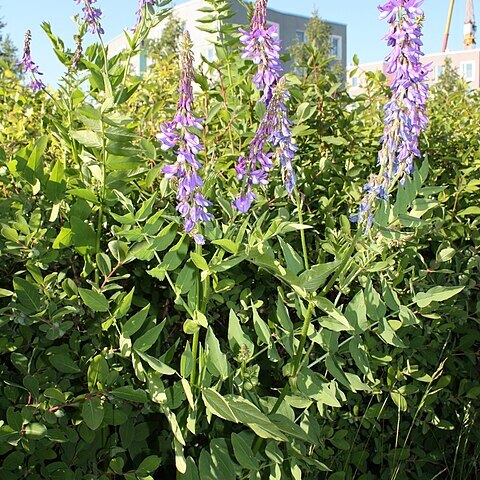Erect herbs. Leaves imparipinnate; stipules green, strongly nerved, rather persistent, nearly always divided into 2 or more acute lobes of which the outer usually points downwards; stipellae nearly always absent; leaflets entire with rather prominent veins set at a small angle to the midrib and running through to the margin or almost so. Flowers borne singly or, less often, in pairs at the nodes of pedunculate racemes which, when axillary, are usually set rather at one side of the leaf-axil; bracts narrow, rather persistent; fruiting pedicels ascending, never reflexed; bracteoles absent. Calyx campanulate, rather persistent, strongly nerved, with 5 equal subulate-tipped teeth. Corolla glabrous, caducous, purplish-blue or less often (outside Flora area) whitish; standard ± twice as long as wide, oblanceolate, tapering gradually, without appendages, to the base; wings slightly shorter than the standard, the blade longer than the claw, markedly auriculate and adhering near its base to the keel; keel as long as the wings, the blade longer than the claw, longer than wide, rather obtuse, broadly and shallowly pouched, notauriculate. Filaments rather persistent, firmly united into a tube for most of their length, not dilated at the tips; anthers uniform. Ovary sessile, 3–6-or, outside the Flora area, 2–12-ovulate, unilocular; style glabrous, gradually curved upwards through 90°; stigma glabrous, small, capitate. Pod unilocular, dehiscent, the sutures not at all impressed, not inflated, with a close network of prominent parallel veins running obliquely upwards (towards the style) from each suture. Seeds oval or rounded-oblong on rather long funicles; hilum small, round, in a well-marked notch.
More
Perennial herbs. Lvs imparipinnate; leaflets entire; lateral veins thin and straight ± to leaflet margin; stipules small or foliaceous. Infl. axillary or terminal, racemose; bracts narrow, often persisting. Calyx campanulate, with 5 subequal teeth. Corolla white, blue, purplish or pinkish blue. Stamens connate into a closed tube; anthers uniform or alternately smaller. Style incurved, glabrous; stigma terminal. Pod 2-valved, not armed, dehiscent, ± straight; seeds estrophiolate.

